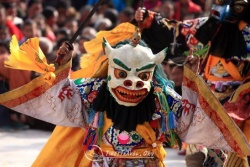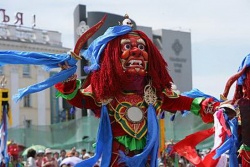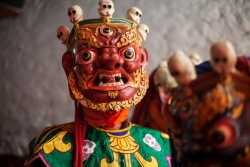Dances in Bhutan: A Traditional Medium of Information by Françoise Pommaret
Dances in Bhutan: A Traditional Medium of Information
Françoise Pommaret[1]
When speaking today of media, we immediately think of the press, TV, internet, films etc., therefore implying that the traditional society had no media, no form of public communication. This note would like to show that, in the past, the performance of religious dances in public throughout Bhutan had contributed to the dissemination of values and religious ideas; and how, today, they are still used to transmit messages to the public, however with a new concern: the risk of being misunderstood or misinterpreted by outsiders to the culture is now present.
It is well-known that through their contents, media transmit values that are often cultural or religious oriented, and that the subliminal messages that any media conveys, are therefore a reflection of the culture in which the media themselves are produced.
In Bhutan, traditional values have always been largely shaped by Buddhist concepts. The dances are performed on auspicious days and are parts of festivals which have different names according to the places. On these occasions, a whole community, which is usually dispersed throughout a valley, gathers at one place at a given time and socializes, making a traditional "media event" in contemporary jargon.[2]
Through a religious event and in an entertaining way, knowledge is imparted to the public who are often not highly educated and cannot read, or have no time to immerse themselves in arduous religious texts. In the context of the traditional society, reading religious texts was considered as the task of the religious specialists, and not so much of the lay people who only read or recite their daily prayers.
Moreover it is well-known that images have a much stronger impact than texts. A contemporary example of this is the Da Vinci Code book by the author Dan Brown. The book, a huge worldwide success is controversial because of its account of supposed events pertaining to the life of Jesus and Catholic faith. For few months, the discussion remained relatively confined to a quarrel among experts and the upper echelons of the Catholic Church. However, the film based on the book which came out this year, provoked a huge outcry in several countries. In India, in May 2006, Catholic groups have sworn to fast to death if the film is screened in the country as it has been taken to be degrading to their beliefs. Protests have also been reported in other Asian countries.[3] The difference in scale of the protests is, in this case, a vivid example of the impact of visual media compared to written media.
The religious dances have a Buddhist information component and Bhutanese religious dances, ‘cham’, can broadly fall into three categories: the subjugation dances, the victory dances and the didactic moral dances.
Although dances impart in one way or another religious teachings to the public, their symbolic meaning can be rather esoteric, and therefore their presentation has to be didactic. For any audience, an enacted story is always more captivating, even if it is a well-known story, so the values are imparted without much effort on the part of the audience.
This point is illustrated by taking some examples among the most popular religious dances. Two of them in particular, Phole Mole and the dance of the Stag and the Hounds (Shawo Shachyi) -also called popularly Acho Pento after the name of the hunter's servant-, carry a strong message, reflecting the Buddhist concepts of retribution, forgiveness and compassion.
The story of Phole Mole touches everybody because it depicts with a bawdy humour a human trait which is found in all societies: infidelity to one’s partner. It is all the more fascinating for the audience because it depicts infidelity among the privileged and ruling class, a human trait which is well demonstrated today by the success of the tabloid press all around the world.
The princesses are unfaithful while their husbands are at war. When the princes come back, they find out and then punish their wives by cutting their noses. This sequence imparts therefore the message of retribution of one's act. However, because of the Buddhist culture, the princes, out of compassion, finally forgive their wives. In many cultures, the retribution is the ultimate value, there is no forgiveness or compassion. This dance therefore contributes to the propagation of two values central to the Buddhist thought.
In the same way, the dance of the Stag and the Hounds narrates the famous story of the conversion of a non- Buddhist hunter to Buddhism by the great 11th century saint Milarepa. Gonpo Dorji, the hunter, is depicted performing non-Buddhist rituals before following his dogs in the chase of a stag. The stag takes refuge near Milarepa who ultimately convinces the dogs and then the hunter to abandon their hunt. Although the hunter tries to kill the saint by shooting an arrow to him, Milarepa does not bear a grudge against him and forgives him, a true altruistic attitude.
This dance/drama, through a concrete and suggestive example, also teaches the public that forgiveness, nonviolence and compassion should be extended not only to human beings but also to all sentient beings, which include the animals. It goes further by demonstrating that an enlightened being such as Milarepa is above petty ordinary emotions and that taming one's mind against anger is an example to follow.
The taming of one's emotions, whatever the circumstances, is a core Buddhist message which is imparted during these dances and grounded in concrete examples with which people can easily identify; it is this strength which makes the dance performance play the role of media.
Other Buddhist messages are given by different dances. Bhutanese believe that a person has to see the Drametse Ngacham of Drametse at least once in one’s life time in order to recognize the deities in the Bardo ("intermediate state") through present life acquaintance. Its message concerns a universal preoccupation, the hereafter, but the dance expresses it in the context of Bhutanese beliefs and culture. This idea is depicted still more vividly in the Raksha mar [mang] cham dance based on the Bardo thos grol text ("Great Liberation upon hearing in the Bardo"). It is a "treasure text" rediscovered in the 14th century by Karma Lingpa[4], and read after the death of a person by the religious practitioners performing rituals. However, when a family grieves of a death or is busy with funeral preparations, nobody listens to a recitation of a text which is meant for the deceased person.
Commentaries of this text are indeed available on the subject. However they are written in a way and in a language that ordinary people are neither accustomed to, nor able to read and they cannot impact the masses as vividly as an enacted story.
In the dance of the Raksha mar [mang] cham, the main performers represent the deities who appear after death. Represented with animal heads, they surround the Judge of the Dead who conducts trials; so the dance is a vivid rendition of what the deceased person is presumed to encounter.
The Bardo thos grol explains the necessity of understanding the meaning of these deities.[5]
- As for the common worldly folk, what need is there to mention them! By fleeing through fear, terror and awe, they fall over the precipices into the unhappy worlds and suffer. But the least of the least of the devotees of the mystic Mahayana doctrines, as soon as he sees these blood-drinking deities, will recognize them to be his tutelary deities, and the meeting will be like that of human acquaintances. He will trust them; and becoming merged into them, will attain Buddhahood. By having meditated on the description of these blood-drinking deities, while in the human world, and by having performed some worship or praise of them; or at least by having seen their painted likeness and their images, upon witnessing the dawning of the deities at this stage, recognition of them will result, and liberation. In this lieth the art.
Regarding the terrifying deities, the Bardo thos grol comments: [6]
- If thou recognize not, and be frightened, then all the Peaceful deities will shine forth in the shape of Mahakala; and all the wrathful deities will shine forth in the shape of Dharmaraja, the lord of Death; and thine own thought forms becoming illusions, thou wilt wander in the samsara.
The text does explain the significance of the deities. However it is the dance which makes it possible for the ordinary persons to have access to this teaching, and therefore to be aware of what to expect after death as well as to realize that ignorance is one of the root poisons which cause the human beings to be reborn.
The text continues with the description of the judgment:
- The good genius, who was born at simultaneously with thee, will come now and count out thy good deeds with white pebbles; the Evil genius, who was born simultaneously with thee, will come and count out thy evil deeds with black pebbles. Thereupon, thou wilt be greatly frightened, and terrified, and wilt tremble; and thou will attempt to say lies, saying that 'I have committed any evil deed'. Then the Lord of Death will say: 'I will consult the mirror of karma'. So saying, he will look in the mirror wherein every good and evil act is vividly reflected. Lying will be of no avail. Then one of the Rakshas of the Lord of Death will place round thy neck a rope and drag thee along.[7]
Although the text is in this case clear, one has to have access to it, and not only read it, but also understand its contents. As in the traditional society that was largely not the case, the dance played an important role as an educational tool and mass communication. It is an alternate means and provides an ideal opportunity for visual information as well as entertainment, therefore filling two of the criteria of a good media.
While watching the Raksha mar [mang] cham, the audience can identify with the characters such as the man who committed sins- who never carried a leg of meat? - as well as with the virtuous man- who never erected a prayer-flag- ? The animal-headed judges, frightening and roaring, surround the deceased person; the black and white pebbles represent clearly the sinful and virtuous acts, the black and white paths are simple enough symbols of the way to hells and heavens. The black demon is scary, all noise and agitation, the white god is soft spoken and calm, the fairies have beautiful ornaments. All the characters and symbols are cultural archetypes set in a way that it is as simple as possible for the audience to understand the judgment and the consequences of one's actions hereafter.
Besides these dances which are didactic in the main, the dances of subjugation, whatever their particular name or esoteric meaning, carry an idea that is central to Tantric Buddhism: the liberation of evil spirits from their present bad incarnation and the duty to lead them to a better sphere. This is done by dismembering an effigy in a ritual killing called grol; the practitioner who performs this killing ritual, must do it not out of anger, but with the right compassionate attitude. The esoteric meaning of these dances is deeply embedded in Tantric Buddhism concepts.
While they can be understood by Bhutanese who are brought up in the symbolic world of this religion, their message is totally "alien" to foreigners coming from other religious backgrounds. This partly explains the fact that these subjugation dances, also performed in other parts of the Himalayas, were called "demon" or" devil dances" by Christian missionaries from the 19th century onwards.
The atsara and their antics during the festival also illustrate this point. They are indispensable in the Bhutanese religious festival context. Their name itself derives from the Sanskrit acarya, philosophy masters, and they teach that masters can appear under any form, even as a bawdy jester. The atsara are there to assist the dancers, and entertain the public during or in the interval of rather solemn dances. Like a talkshow host on TV today, they transcend the hierarchy of the society and have a mass appeal with their mockeries and sexual jokes, but they know their limits in the context of Bhutanese society.
However, when they encounter foreigners during the festivals, they step into another world where they have no cultural references and therefore no boundaries. The way atsara perceive foreigners and how foreigners perceive atsara is a reflection and distortion of each other's culture through mutual ignorance. If we speak in contemporary terms, for the foreigners the atsara are just clowns and their religious function is not apparent.
Therefore in the religious dances, as in modern media forms, the meaning of the images can be easily distorted, used for a totally different purpose, and misunderstood by people who are not familiar with the religious and cultural ideas.
The dances, by being performed throughout Bhutan, also disseminated cultural values and therefore, like Dzongkha programmes on BBS today, contributed in forging the country's identity. For example, the Drametse Ngacham which was awarded in 2005 the title of Master-piece of Intangible Cultural Heritage by UNESCO, came to represent an aspect of the identity of Bhutan. At the beginning, it was a dance taught in the 16th century by Khedup Kuenga Gyeltshen, a descendant of the treasure discoverer Padma gling pa (1450-1521) after he had a vision of Guru Rinpoche's palace in the remote village of Drametse (Eastern Bhutan). The dance became the symbol of this community, hence its name and for two centuries, it did not go out of the confines of the Drametse Thegchog Ogyen Namdrol Choeling monastery courtyard. This dance was introduced in other parts of Bhutan only towards the end of the 19th century when it was performed in Talo monastery in western Bhutan for the first time during the visit of the Zhabdrung Jigme Choegyal (1862-1904) who was from Drametse. Later, it was introduced in Trongsa at the initiative of the second king (Jigme Wangchuck reign: 1926-1952). Thereafter, with its powerful visual content and religious value, the dance gradually spread to the rest of Bhutan, thus disseminating information about the Pad gling lineage and religious teachings.
In fact, all dances performed in public, including folk dances, can be seen as traditional media. Folk dances, such as the Wuchubi zhey of Paro, Nubi zhey of Trongsa, the Laya dances, the Gon zhey of Gasa, or the Ache Lhamo of Merak Sateng, to name a few, have historical and religious contents which go beyond their local community. They reflect historical or mythical events which contribute to the knowledge of Bhutan's past.
Because they are nowadays performed more frequently around the country or on TV programmes, these dances, once confined to their respective region of origin, have two important outcomes, besides entertainment: Bhutanese learn about the customs, history, and beliefs of a part of the country they may not be familiar with; at the same time, the dances become part of the mainstream repertoire and thus contribute to national identity.
Mass impact, concrete and relevant examples, easy communication and cultural values messages are criteria which give some dances, either religious or folk, a real media role in traditional Bhutan.
Phuntsho Rapten wrote about the modern media in Bhutan:
- As media audiences have different individual backgrounds, intelligence, interests and attitudes, these invariably influence their perceptions and interpretations about the incoming message and therefore the impact varies.[8]
The same can be said of religious dances. In contemporary Bhutan which has opened to the outside world, the dances can still be a powerful vector of values and play an educational role, especially if they are supported by modern media forms. However seen by people of different cultural backgrounds and in the context of the invasion of global media networks, their interpretations and impact might be experiencing a challenging change of focus.
Footnotes
- ↑ Director of Research, CNRS, Paris; Advisor, ILCS, Royal University of Bhutan, (RUB), Thimphu
- ↑ Kinga, 2001, 135, made the same remark regarding songs.
- ↑ news.bbc.co.uk/go/pr/fr//2/hi/entertainment/4987116.stm, published, 6 May 2006.
- ↑ He was the author of the zhi khro dgongs pa rang grol cycle from which the Bardo thos grol is extracted.
- ↑ Evans-Wentz, 2004, 132-133.
- ↑ ibid. 147
- ↑ ibid. 165-166
- ↑ Rapten, 2001, 189.
Bibliography
- Cuevas, Bryan J. (2003). The hidden history of the Tibetan Book of the Dead, Oxford University Press, Oxford.
- Dorji, Sithel Dasho, (2000). The Origin and Description of Bhutanese Mask Dances, KMT Press, Thimphu (dPal ldan 'brug pa'i 'cham gyi 'byung khungs dang le'u bshad).
- Evans-Wentz, W.Y (2004). The Tibetan Book of the Dead, Wisdom Books India, New Delhi.
- Kinga, Sonam, "The attributes and values of folk and popular songs", Journal of Bhutan Studies, Vol.3 No.1, Summer 2001, 132-170.
- Rapten, Phuntsho, "Mass Media: its Consumption and Impact on Residents of Thimphu and Rural Areas", Journal of Bhutan Studies, Vol.3, No.1, Summer 2001, 172-198.
- Wangyal, Tashi, “Ensuring Social Sustainability: Can Bhutan's Education System Ensure Intergenerational Transmission of Values?" Journal of Bhutan Studies, Vol.3 No.1, Summer 2001, 106-131.








